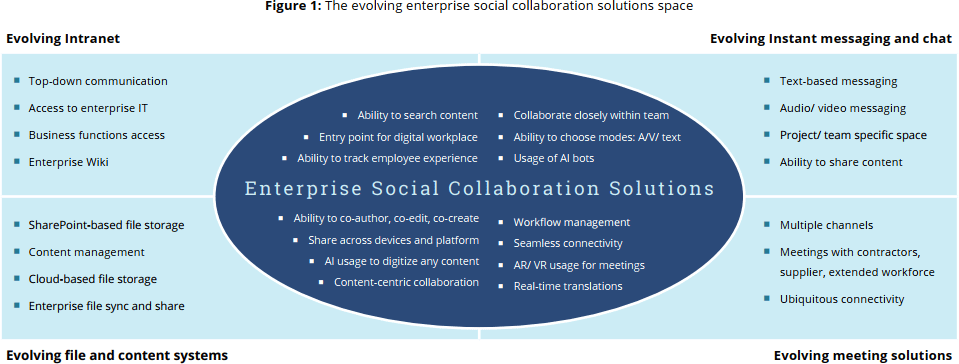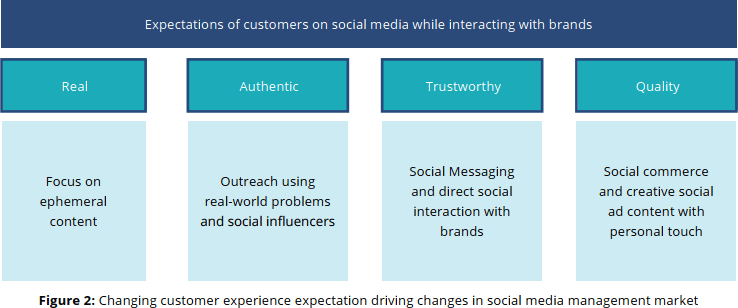ISG Provider Lens™ Social Business Collaboration – Services & Solutions - Global 2019 - Enterprise Social Collaboration Solutions
Digital Dexterity not Tools Define Social Business Collaboration
Social business collaboration is defined by user behavior and growing affinity toward digital technology and not by technology itself. The word “social” is derived from the Latin word “socii” which means “allies.” Social collaboration technologies help users identify, work with and for others with similar traits and behaviors. This human-like behavior drives changes in the enterprise social business technologies for internal collaboration, external marketing and customer support services.
Enterprise Social Collaboration
The social business collaboration space in the enterprise environment is witnessing rapid growth and changes. Enterprises are increasingly focusing on working efficiently with geographically spread teams on specific tasks and projects. With the rapid growth of the millennial working population and improvements in different tools, the increase in users’ digital dexterity is governing the evolution of new technologies and tools.
Modern enterprise social collaboration has broadly evolved into the following four segments of traditional collaboration tools and solutions:
- Evolving intranet: Many enterprises still rely on the traditional intranet approach for top-down communication with different business functions accessible by end users. Modern intranet solutions focus on being the entry point of the digital workplace for end users. These solutions are being designed with ubiquitous availability and connectivity in mind. As users become digitally mature, they expect intranet solutions to provide easily searchable content from knowledge management systems or enterprise wiki. From a business perspective, management would want to know the overall satisfaction levels and response rate of employees toward top-down communication.
- Evolving instant messaging and chat: Instant messaging and chat applications enable one-on-one communication between end users. These have turned out to be among the most effective tools for collaboration for end users separated by distance. With the inclusion of audio/video capabilities, the effectiveness of collaboration has increased to a new level. Experienced users expect more automated responses and artificial intelligence (AI)-enabled bot usage. Modern enterprise team chat and instant messaging solutions focus on providing a team or project-specific working environment with the ability to collaborate over content, audio/video chat, automated integrations with different business functions and workflow management.
- Evolving file and content systems: While basic content collaboration is still possible on email, cloud-based file system solutions have evolved to provide enterprise file sync-and-share services. At the most basic level, these solutions can provide cloudbased file storage and retrieval systems and can also sync content across platforms and devices. Experienced users are increasingly expecting these solutions to work on different types of content. Modern content collaboration solutions offer co-authoring, co-editing and version-control functionalities. They also provide customized solutions for several business function use cases and offer integration with other widely used productivity solutions.
- Evolving meeting solutions: Chat and communication solutions generally provide multi-channel communication options such as virtual meetings and webinars to connect with extended workforce, contractors, suppliers and even customers outside the organization. Users with adequate experience expect these solutions to provide ubiquitous connectivity and communication outside enterprise boundaries. This could also involve using technologies like augmented and virtual realities to translate a physical meeting into a virtual one or live translations and note taking.
As these solutions evolve with the inclusion of more digital technologies, they all converge in the modern enterprise social collaboration space as illustrated in Figure 1.
Due to the convergence of these solutions, the enterprise social collaboration space is witnessing competition among firms that used to provide pockets of collaboration services. Over the past couple of years, many vendors and solution providers that could not position their solutions in any of these four buckets have exited the market. Those still competing are focusing on continuously improving their solutions because of the changing digital expectations of users. However, the most prominent trend is that each vendor is evolving in its own bucket of offerings and subsequently encroaching the space of other vendors offering solutions in another bucket. With the continuous evolution and improvements, these vendors are strongly competing in the common enterprise social collaboration space.
An enterprise should specifically evaluate its key requirements and expectations from a social collaboration solution. It should not ignore the working style and employee demographic before choosing a collaboration solution. This decision cannot be taken by enterprise IT alone because its priorities usually involve choosing a solution that integrates easily with the rest of the workplace ecosystem. The solution that best integrates with existing systems may not offer the collaboration features that end users are expecting or may not be able to generate measurable results for business. Hence, the decision to choose the right collaboration solution requires a common understanding among business functions. Departments like human resources (HR) and corporate communication should work together with the technology or enterprise IT group to make this decision.
External social media communication and marketing
Like enterprise internal collaboration, the external social media collaboration and marketing space depends heavily on improving the digital dexterity of users. Social media management and customer support services rely on the changing expectations of end users or customers through their interaction with brands on social media channels.
Users are becoming familiar and are getting comfortable with different ways to access and use social media on different devices and platforms in the digital world. Based on their social media usage, it is possible to distinguish between a digitally dexterous expert social media user and an average user. With the emerging possibilities with social media channels over different platforms, users’ expectations and experiences have also evolved. Key trends in this space are mentioned below and summarized in Figure 2:
- Brands focusing on digital enablement through social media: Customers have become inconsistent in their product choices due to the increase in the number of options available. Brands often end up copying their competitors’ efforts on social media marketing, which only leads to incremental improvements. Customer experience, as well as the elements of digital enablement, is growing at a rapid pace. Brands that understand this trend offer more capabilities to drive a digitally enhanced customer experience on social media channels.
- Trust, control and privacy on social media: Over the last few years, online customers have been questioning the privacy, accuracy and ethics of every social channel. With the dawn of social skepticism, users have become somewhat distrustful of social media and influencers. To keep pace with these changes, smart brands are focusing less on maximizing reach and more on generating transparent, quality engagement. Rather than relying on celebrity influencers, brands are leveraging their own internal experts and employee advocates. As customers seek real and authentic interactions, brands should focus on earning trust and providing real value for continued engagement.
- Sharing stories online: Nearly a billion users of WhatsApp, Instagram, Facebook and Snapchat are using the stories feature to share content on social media. Stories are ephemeral and often disappear after a day, leaving room for experimentation. They feel real, immediate and personal. Those that are less polished feel more realistic and perform better than heavily edited posts. The absence of a strong application program interface (API) for Instagram stories makes scheduling, measuring engagement and ROI very problematic.
- Paid social media: Rising costs and short-lived attention for paid social media posts limit ROI for brands and reduce overall margins. Impressions, views and other reach metrics are rarely indicative of campaign effectiveness because the background noise on social media has increased enormously. Social ads with a high level of engagement rise above this background noise. Paid social teams are recognizing the importance of combining ad spend with an equivalent investment of time and creativity for the right target audience. The end goal should be customer engagement and user discussion. This should be achieved by sharing creative social ads that are personalized and entertaining.
- Social commerce: The adoption of social commerce in Asia has been rapidly growing as new-generation consumers are opting to buy directly via social channels. However, North America has been slow in this aspect because of the gap between consumers with a strong purchasing power and avid social media users. Shoppable posts on Instagram, Facebook Marketplace and Buyable Pins on Pinterest are some examples of social commerce destinations. Determining the ways to make shopping live, interactive and seamless on mobile and desktop devices is key to boosting sales on social platforms. Brands need to replace written product descriptions with videos, share live demos and encourage video testimonials from customers. Peer engagement, trust and creative visuals on social media will change the ecommerce landscape over the years. Social commerce is not expected to be a separate entity from commerce in the future, and the top brands will integrate brand building, social media, and social commerce into seamless experiences that meet consumer expectations.
- Social Messaging: Messaging has become the single most preferred channel for customer service. Customers are more confident when they get to directly communicate with a brand. Smart brands are using messaging apps to enable highvalue conversations. Customer service is an opportunity to build empathy, so brands are using bots to build rapport with their customers. The increase in messaging volume raises the need for a unified inbox for brands, which will serve as a cross-channel platform for catching, routing and responding to all messaging queries. Most of the leading social media management solution providers can help brands with a unified social inbox and handle the customer service process.

